Planning July 2020
Coming Soon to a Neighborhood Near You?
From siting and permitting to the digital divide, 5G offers U.S. communities a full spectrum of opportunities — and challenges.
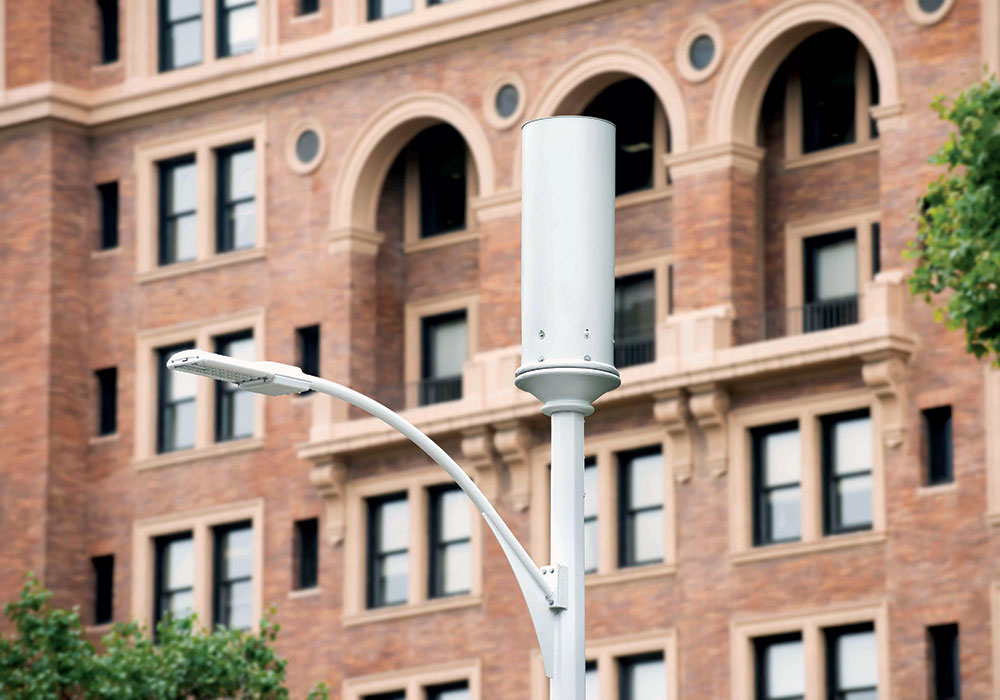
A small cell on a light post in Pittsburgh. Photo courtesy Crown Castle.
By Daniel C. Vock
Fifth-generation, or 5G, data networks promise to transform cities — even society — with network speeds more than 100 times faster than the 4G networks that most of our mobile phones currently use to transmit information. 5G can also handle 100 times as many devices as current 4G infrastructure, which could allow everything from parking meters to air quality sensors to constantly share information in real time, potentially paving the way for truly "smart" cities.
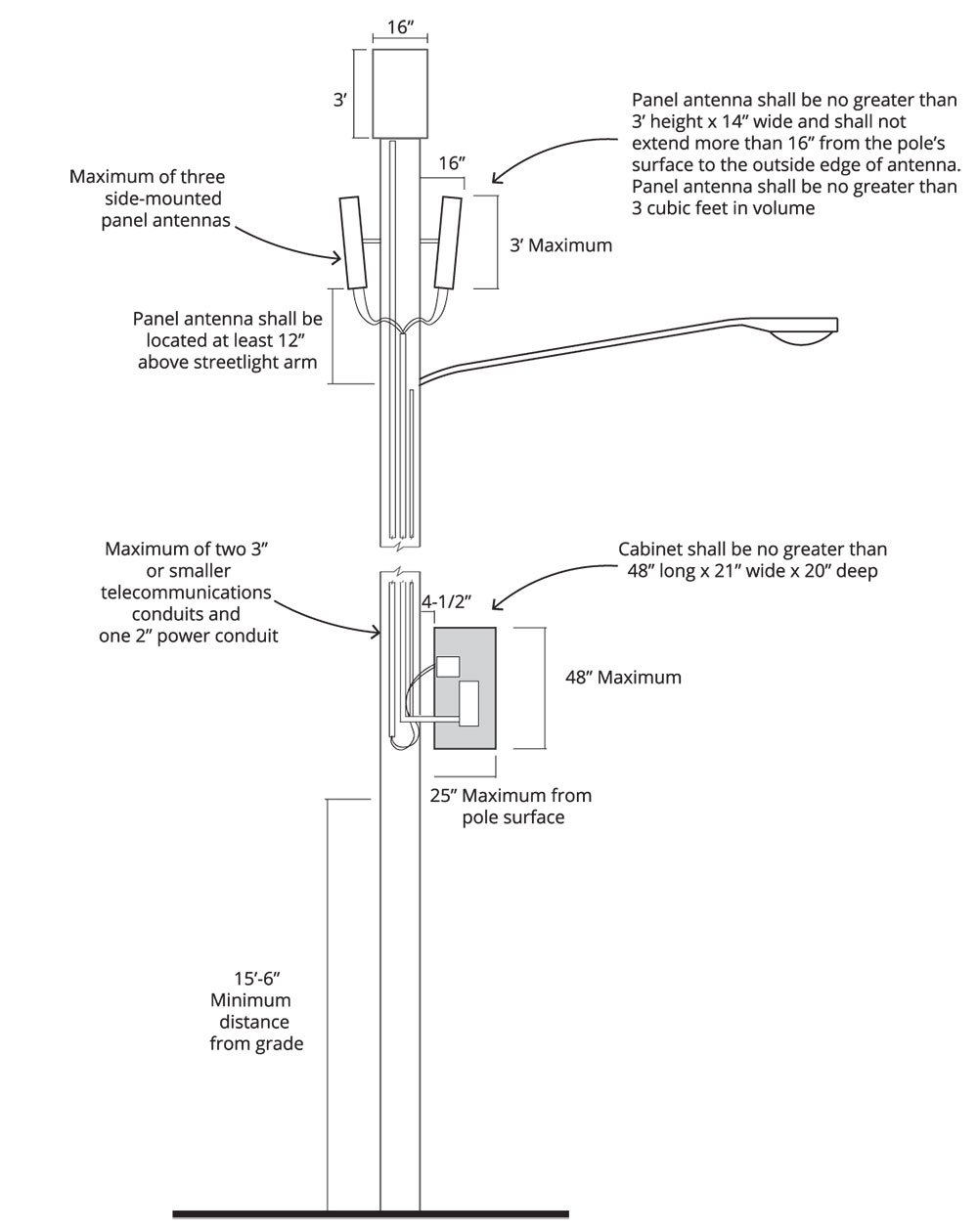
A diagram of Seattle's design guidelines for a waterfront metal pole top-mount antenna. Seattle published its design standards for small wireless facilities earlier this year. Courtesy Seattle Department of Transportation.
These upgrades in speed and capacity could facilitate the deployment of a whole new range of applications, from surgeons operating remotely on patients hundreds of miles away to autonomous vehicles that communicate with nearby cars, trucks, and road infrastructure as they navigate city streets. The higher speeds would also make it easier to facilitate live video conferencing and other interactive forms of communication like virtual reality that make it easier for people to work, study, or socialize from home — functions that are front of mind for many during the COVID-19 pandemic and will likely continue to be as we look to the future.
Despite this potential, many cities have been wary of carriers installing 5G infrastructure. One way 5G equipment can carry so much more information than current equipment is by using higher frequency electromagnetic waves. But they don't travel as far as lower frequency waves, just like FM radio stations broadcast a clearer signal than their AM counterparts but don't have nearly the same range. That means, in order for 5G to work, carriers must install far more equipment, which is often mounted on existing infrastructure, like light posts, utility poles, and buildings.
The total number of cell sites, by one industry estimate, would increase by 769,000 by 2026 to achieve nationwide coverage. That's in addition to the 350,000 5G sites installed in 2018.
The 5G small-cell equipment is smaller than its predecessors — meaning it can hang from streetlights or utility poles — so wireless companies have pushed for the ability to mount them on public infrastructure. Each of the small cells has to be connected to fiber optic cables, which requires tearing up city streets where they're not already installed. All of that means costs to cities, which many local governments are trying to pass along to the mobile carriers through permit and rental fees.
Disputes between municipalities and mobile carriers over the size of the fees local governments can charge and the placement of 5G equipment are playing out in state legislative chambers, federal regulatory hearings, and more than a few courtrooms. The outcomes will have big implications for planners and the communities they serve, from the short-term surge in permit applications coming to cities and in the long-term consequences on disparities among residents in the types of technological resources they will have in their neighborhoods.
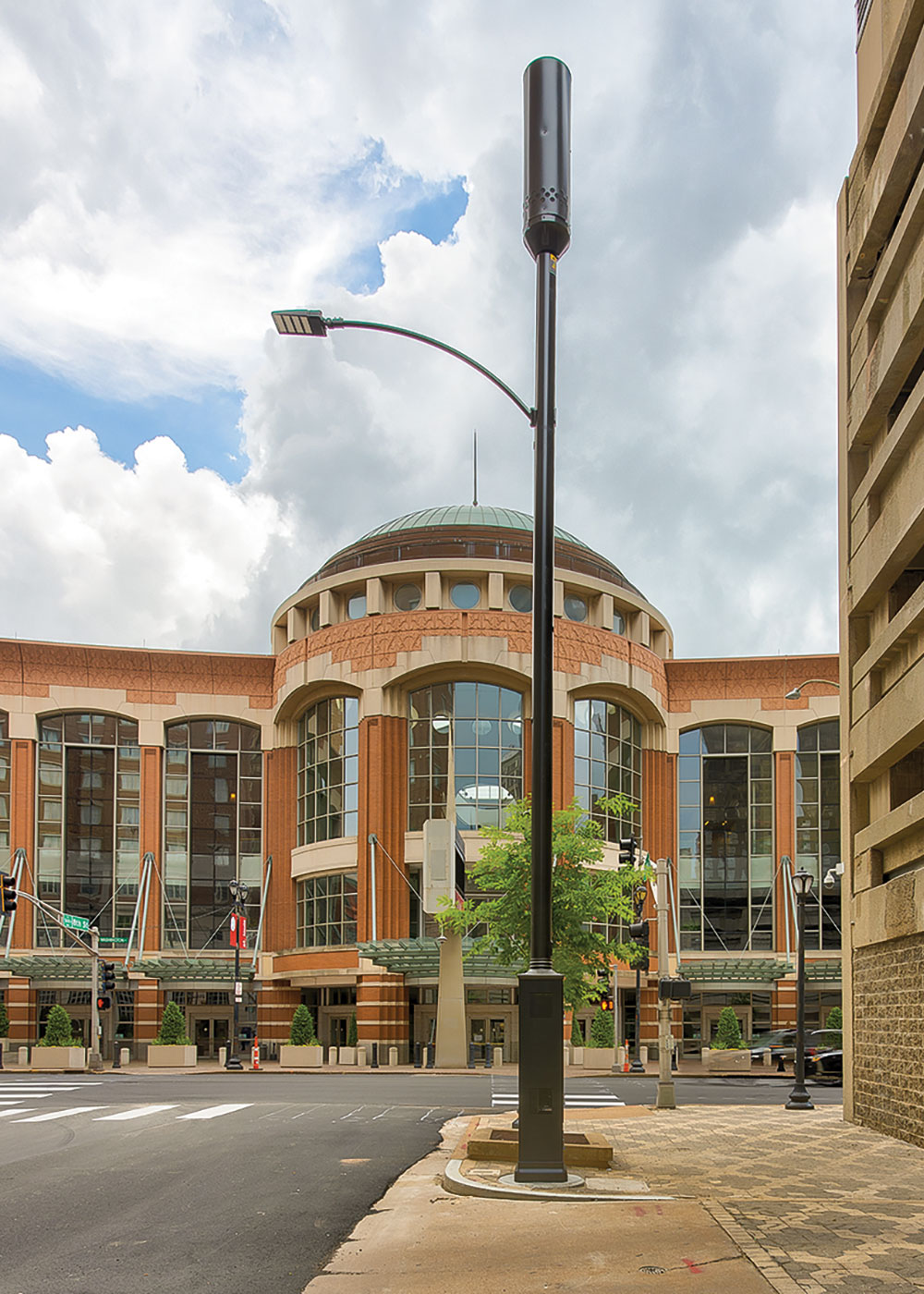
5G Installation Option: A partially concealed small cell topper on a light pole in St. Louis. Photo by Raycap.
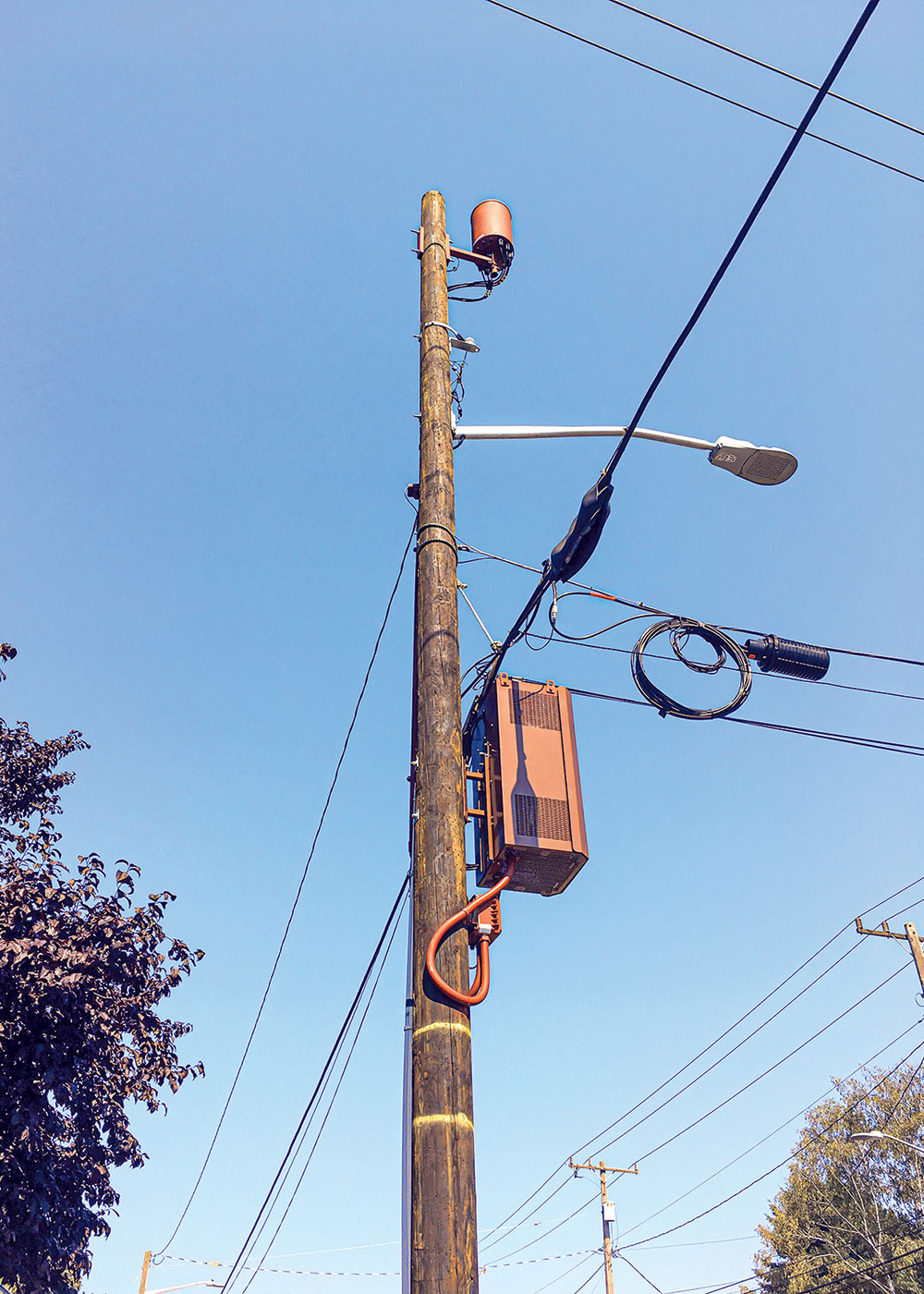
5G Installation Option: Mounted on a combination lamp post and telephone pole in Seattle. Photo courtesy Seattle Department of Transportation.

5G Installation Option: On a rooftop. Photo by TProduction/iStock/Getty Images Plus.
5G-friendly approach
One of Paul TenHaken's first actions after becoming mayor of Sioux Falls, South Dakota, in 2018 was to try to convince mobile phone providers to install the next generation of high-speed data networks in his city's downtown.
Where officials in many cities see obstacles with 5G, TenHaken recognized opportunity. He saw the "fast, reliable connectivity" of 5G as a way for local companies like CarsForSale.com and Experity, a provider of medical records software, to thrive. He also thinks the faster network would help telemedicine, allowing doctors from elsewhere in the state to consult virtually with specialists in Sioux Falls and eliminating the need for patients to drive hours each way for appointments. "The potential [of 5G technology] is great and the benefits are tremendous," says TenHaken.
He promoted Sioux Falls as an easy place for carriers to install 5G technologies in the hopes that mobile companies would choose it as one of the first cities they upgraded. "The strategy for the city of Sioux Falls in dealing with wireless carriers was simple: cover our costs," TenHaken testified before a congressional committee in December. "As mayor, it is not my intent to profit off carriers to deploy small cell infrastructure."
The strategy worked. When Verizon expressed interest in 2018, Sioux Falls engineers and lawyers worked with the company's representatives to develop a 5G permitting process. City workers processed mock applications for small-cell antennae installations to figure out how much time it would take them to decide whether to approve an application, and how much to charge the companies to apply for a permit. Sioux Falls employees also researched the costs for electricity and pole maintenance to help determine annual rental fees.
In the end, the city let Verizon lease its poles for 10 years, with the option for a five-year extension. Sioux Falls charged $500 per pole in application fees and $175 per pole in rental fees annually. It also agreed to process all applications within 60 days. Verizon began offering 5G service in Sioux Falls in November 2019, making the city of 200,000 people one of the first 18 nationwide where Verizon offered the service. The mayor expects other wireless carriers to follow.
"While states in middle America are often overlooked because we lack the population sizes compared to the coasts, our infrastructure needs are equal to those of the largest states in the nation," TenHaken told the senators last winter. "In a global economy reliant on the internet, the fifth generation of mobile infrastructure is not a ‘nice to have' asset for Sioux Falls — it is a necessity."
How Does 5G Work?
5G's shorter wave signals can degrade if they encounter structures, vegetation, or rain. That means more cell towers are required to relay signals from the macrocell, or high-power, tower. 4G's longer wave signals travel for miles from the macrocell tower, unaffected by weather or buildings, but more users can slow down service.
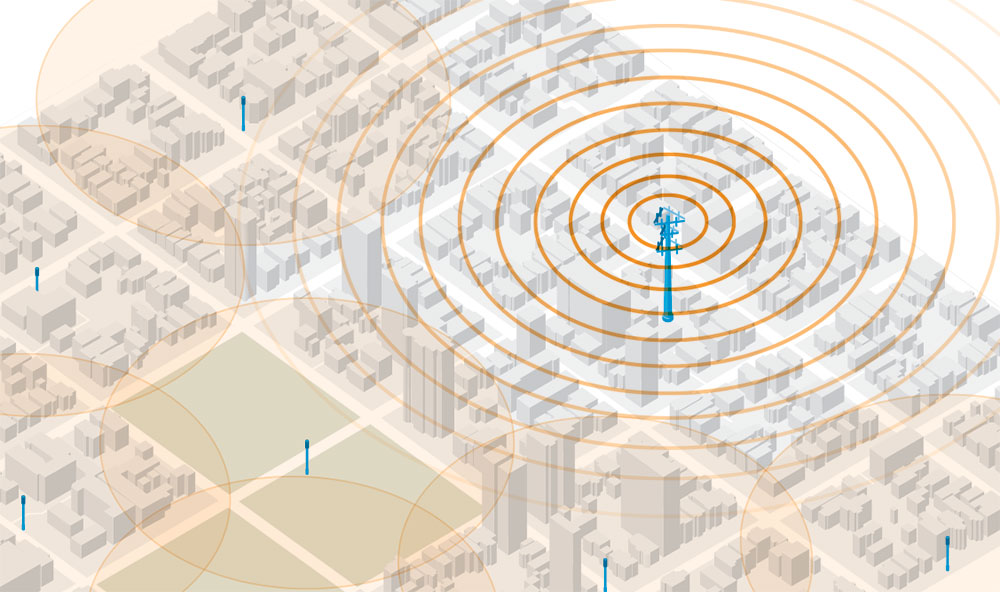
Image by Haisam Hussein.
5G technology relies on more cells than its predecessor systems in order to transmit the shorter wavelength signals. Cells can be mounted on new or retrofitted infrastructure.
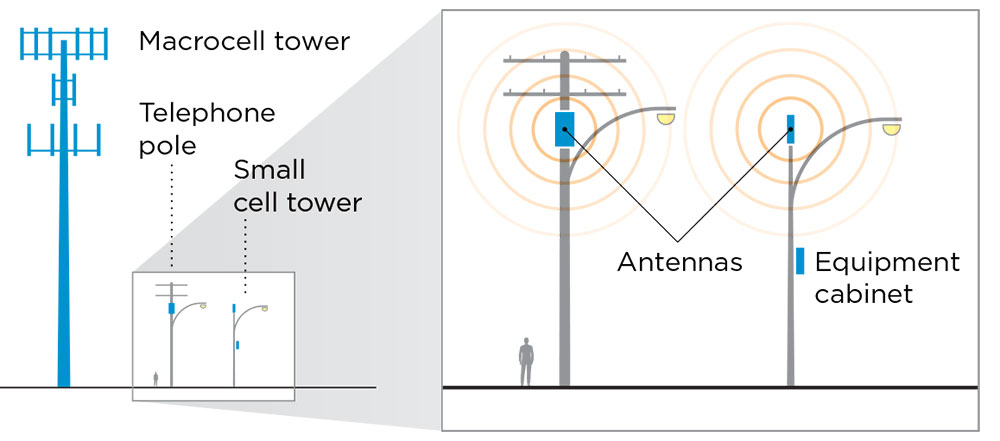
Image by Haisam Hussein.
Regulatory debates
The technology that is broadly labeled 5G is actually a collection of improvements to wireless infrastructure that will boost speeds for end users. It uses different parts of the electromagnetic spectrum — and more of it — than its predecessors and incorporates several ways to use those signals more efficiently. But the exact types of upgrades depend on the carrier and on the location. For example, rural areas may see faster connections compared to existing 4G networks, but not the top-of-the-line speeds available in downtown business districts. On the other hand, those downtown districts will require a lot more antennae, spaced closer together, in order to get those higher speeds, because the equipment used to produce those higher speeds uses high-frequency wavelengths that can be blocked by buildings and other structures.
Major wireless carriers have all started rolling out 5G technology in the U.S., but so far, those efforts are still in their early stages. (To make matters more confusing, AT&T rebranded some of its 4G network as "5G E," which is not actually 5G.) The only consumers currently able to take advantage of the upgrades have to have a 5G-enabled device, but most mobile phones — including the Apple iPhone — are not currently equipped to work with 5G technology.
But Verizon and AT&T both indicated this spring they plan to ramp up the construction of 5G infrastructure, which prompted Politico to ponder whether there would be a post-virus "5G gold rush."
Even before the pandemic, the telecommunications industry had planned wider rollouts of 5G throughout 2020. Not only are companies competing with each other to offer the new service, they're also trying to position the U.S. as the global leader in deploying 5G technology in order to attract developers and technology companies.
To speed up the process, the telecommunications industry has tried to bypass many local siting and permitting regulations that it sees as too cumbersome. Companies have worked at state and federal levels to get uniform standards imposed on localities that cover things like how much the municipalities can charge for leasing light poles and other infrastructure, how long the local regulators can take to decide on whether a permit should be issued (what the industry refers to as "shot clocks"), and when local regulations should be preempted.
By and large, the telecommunications companies have been successful. More than half of the states in the country have passed laws setting standards for municipalities to follow for 5G equipment installations, according to the Wireless Infrastructure Association, an industry group.
The bigger shock came when the Federal Communications Commission passed sweeping regulations in 2018 imposing similar restrictions on municipalities nationwide. The FCC rules order limited application fees for small wireless equipment to $500 for the first five sites and $100 for sites beyond that, and capped recurring annual fees to cover the cost of maintaining rights-of-way at $270. They also limited aesthetic requirements that would apply to rules published in advance that were "reasonable" and no more burdensome than the rules for other types of infrastructure. The FCC also stipulated that municipalities must rule on applications for sites where small cells already exist within 60 days and on new sites within 90 days.
Local government groups, including the National League of Cities and the National Association of Counties, denounced the new rules. San Jose, California, and 22 other cities and counties, meanwhile, have sued the FCC over the regulations. They argue, among other things, that the FCC overstepped its authority by issuing the directives.
Under federal law, municipalities cannot ban telecommunications services or equipment in their jurisdictions. The FCC regulations rely on that principle to build the time limits for applications; municipalities that take too long to process applications, for example, are presumed to be prohibiting the new service. Opponents claim that is too much of a stretch to meet legal criteria. The cities' lawsuits were combined and are now before a San Francisco-based federal appeals court. Meanwhile, the underlying regulations remain in effect.
Deployment priorities
Brian Dillard, chief innovation officer for San Antonio, Texas, is wary of industry promises about the benefits that 5G will bring. His primary focus is on promoting equity among San Antonio residents, which, he says, is not a priority for telecommunications companies. He anticipates mobile carriers will roll out 5G much the same way they introduced 4G: in the most affluent neighborhoods first.
The delays in bringing modern internet connections to lower-income neighborhoods have lasting consequences, Dillard says. The COVID-19 pandemic brought the issue into clear focus when a local school district tried to distribute 500 mobile hotspots to students to facilitate at-home learning. He says that many students couldn't use them because the devices required a common mobile technology that wasn't available in their neighborhoods.
"If the telecoms are telling [planners] that 5G will solve all their problems, make them prove it. We have big problems of economic segregation. Those are the problems we need to solve. Digital inclusion can be a big part of it," Dillard says. But that would require the companies to upgrade already lagging infrastructure in neighborhoods. "Go out to this neighborhood and fix that problem first, before you get to the next level," he says.
Many planners, community activists, and city officials welcome the upgrades in technology but, like Dillard, are more worried about how and where they will be deployed. Even in areas with ample services, many residents can't take advantage of the improvements because they lack the money to pay for them or the skills to use them.
"There's nothing different that I know of with the traditional [telecommunications] business model that will make 5G more equitable," says Brenna Berman, CEO of the Chicago-based City Tech Collaborative, which works with private companies and cities to address urban problems. She says policy makers should explore other business models to encourage the providers to better serve disadvantaged populations. "We have a moral obligation to make sure that we don't further broaden that digital gap, and the time to think about that is now," she says.
Eric Frederick, AICP, vice president of community affairs for Connected Nation, which focuses on bringing better internet connectivity to rural areas, says many of the physical features of 5G — particularly its reliance on high-frequency transmissions and fiber optic networks — mean that "5G is not going to be a rural broadband solution." The spreadout nature of rural areas, low densities, and topographic features mean rural 5G is not a great match.
Technical specifications aside, Frederick says investment and market forces pose barriers to rural deployment as well. The FCC announced it would award $9 billion in grants for rural areas, but Frederick says that's only a fraction of what would be needed. Besides, he adds, there's not a lot of state or federal regulation to determine where new service is provided, so the carriers' decisions are market driven and almost always go to areas where they can serve the highest number of households in a small space.
That doesn't mean local governments' hands are tied. Frederick says planners should think ahead about the type of internet access they want in their communities and include plans to secure it in their long-term planning documents, as New York City did earlier this year. At the same time, they should start building relationships with their local telecommunications providers, even if the administrators are based far away. "It's worth the effort," he says.
Planning for demand
From the perspective of infrastructure installers, making the permitting and application process for new 5G equipment uniform and easier for applicants can encourage the deployment of new network equipment in more neighborhoods, says Karmen Rajamani, the director of permitting and utilities for the eastern U.S. region for Crown Castle, a company that installs and owns telecommunications equipment and leases it to providers around the country.
Crown Castle only builds network infrastructure where there's already demand for the upgrades. But demand often grows when the new service is available in nearby areas. "We've found that once [infrastructure improvements] are installed and used, then they grow," Rajamani says. She also stressed that communities should have "frank conversations" with infrastructure companies and mobile carriers to convey their priorities.
Jonathan S. Adelstein, president and CEO of the Wireless Infrastructure Association, says low-income neighborhoods are actually attractive to mobile carriers. Those areas tend to be densely populated and, because residents there rely so heavily on their mobile devices for internet connections, they tend to prioritize paying their bills for wireless service.
But he cautions against city officials interfering with the carriers' plans for 5G deployment. "Carriers are looking at rational investments. They are going to go where the customers are. But they have limited capital venture. Even though they'll be spending $30 billion a year mostly for 5G, it still is not enough to meet the need," he says. "If you try to artificially change where investments go, you will get no investments. Some cities have the leverage to pull it off, but some don't. They could end up with less net investment rather than more."
Dillard, the San Antonio innovation officer, encourages cities to mobilize their residents to make sure 5G service is rolled out fairly. Building those networks will take three to five years, but cities need to be active as it happens, he says. "Keep awareness of where [coverage] is and where it isn't. Make it physically aware to residents with network maps, and don't go a year between updating them," he says. "Get residents involved, because residents are going to demand something better."
Daniel C. Vock is a public policy reporter based in Washington, D.C.
Resources
Small Wireless Facilities and Facilities in the Right of Way: APA's Knowledgebase Collection lets you search for small wireless resources that provide background, policy guidance, and examples of local zoning and other municipal standards from across the country.
Right-of-Way Management: Small Cells to Scooters: Learn how to manage the public right-of-way and regulatory tools for best practices, and understand the challenges presented by small wireless facilities and shared mobility services.
Equal Access Equals Opportunity: Planners in small towns and rural areas are increasingly looking to broadband to spur local growth and prosperity. Eric Frederick's July 2019 article in Planning explains.
What's Next for 5G?

Conspiracy theories about 5G have sparked worldwide protests, including this one in London in January. Photo by Kevin J. Frost/Alamy.
As telecommunications providers introduce 5G to more areas in the coming years, here are a few issues that may determine how that rollout progresses and how it will benefit consumers.
Litigation
Three judges considered the fate of the FCC regulations on 5G regulations during a February hearing in a courtroom in Pasadena, California. Lawyers for municipalities and the FCC sparred over many aspects of the order, and whether the extensive rules would, for example, allow Pasadena to halt construction on 5G projects while it erected grandstands for the Rose Bowl parade or require the city to let telecommunications companies put antennae on its decorative streetlights.
It could be months before the three-judge panel of the U.S. Court of Appeals for the Ninth Circuit rules on the case, but more litigation is likely to follow.
Disinformation
Perhaps it's not surprising that, as a new technology, 5G has already been the subject of conspiracy theories and hoaxes. What's more troubling for industry leaders is that at least some public officials have believed the hoaxes and considered trying to ban 5G equipment altogether.
That was the case in Trenton, New Jersey, where city council members drafted an ordinance to ban construction of wireless infrastructure after they received a letter alleging that "wireless providers are using the COVID-19 emergency as cover to expand and cement their rapid and virtually unsupervised deployment of harmful wireless infrastructure." There is no evidence that wireless infrastructure is harmful, and the Trenton ordinance never passed.
Other hoaxes and conspiracy theories persist. Vandals in the United Kingdom tried to set fire to some 50 cell towers and other equipment, and attacks have happened in other European countries after false information spread linking 5G and the spread of COVID-19. The hoaxes could be coming from coordinated misinformation campaigns backed by a foreign government or other entity, internet researchers say.
The spread of misinformation could have real consequences if local officials believe it or don't stamp out rumors, says Jonathan S. Adelstein, president and CEO of the Wireless Infrastructure Association. Carriers will shy away from installing infrastructure in places where they know they will encounter resistance for "spurious reasons."
Ripple Effects
The benefits of installing 5G could extend beyond the mobile customers who use it directly. Small cells require direct connection to fiber optic cables, and those super-fast lines could also be used to extend land-based broadband to nearby areas too.
"It provides more options for other last-mile broadband providers to purchase their backhaul. If a new subdivision is equipped with a 5G cell, now other [internet service providers] can connect with that fiber as well. That is a big benefit of 5G," says Eric Frederick, vice president of community affairs for Connected Nation. Many neighborhoods getting 5G will already have plenty of infrastructure, he notes, "but at the edges, you're going to see spin-offs."
Adelstein says the network improvements will create value throughout the economy, much in the same way that the rollout of 4G to power smartphones led to a surge in tech innovations like streaming video and delivery apps. "People don't think about the fact that they wouldn't have Uber without 4G," he says.


